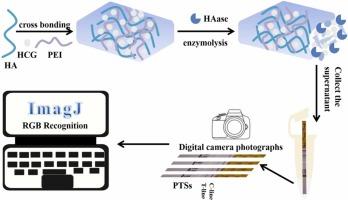Point-of-care testing of hyaluronidase in the urine using commercial pregnancy test strips as readout
IF 3.7
1区 化学
Q1 CHEMISTRY, ANALYTICAL
引用次数: 0
Abstract
Elevated hyaluronidase (HAase) concentration has been found in the urine samples of the patients with bladder cancer and development of simple but sensitive detection methods for HAase is important for related disease screening. Pregnancy test strips (PTSs) is one of the most common portable and inexpensive household testing strips, which has been used to measure human chorionic gonadotropin (HCG) in urine sample for pregnancy test. In this study, a portable biosensor has been developed for HAase using PTSs as detection device. HCG was embedded in a hydrogel format through the cross-linking of hyaluronic acid (HA) and polyethylenimine (PEI). The presence of HAase can digest HA in the hydrogel and results in the releasing of HCG, which can be detected by a PTS easily. The color changing of the test line (T line) indicates the existence of the target object and the depth of color can be used for semi-quantitative detection of the target concentration. The ImageJ software was used to extract the RGB value of the color of T line. The different of the RGB value (ΔRGB) at present and absent of target has a strong linear correlation with the HAase concentration between 1 U/mL and 100 U/mL, with a limit of detectionof 0.27 U/mL (S/N = 3). The proposed method was used to detect HAase in urine samples from non-pregnancy healthy individuals and patients diagnosed with bladder cancer as a demonstration.

尿中透明质酸酶的即时检测使用商业妊娠试纸作为读数
膀胱癌患者尿液中透明质酸酶(HAase)浓度升高,建立简便、灵敏的HAase检测方法对筛查相关疾病具有重要意义。妊娠试纸条(pts)是一种最常见的便携式、廉价的家用试纸条,已被用于测定尿样中的人绒毛膜促性腺激素(HCG)。本研究开发了一种便携式HAase生物传感器,以PTSs为检测装置。HCG通过透明质酸(HA)和聚乙烯亚胺(PEI)的交联以水凝胶形式嵌入。HAase的存在可以消化水凝胶中的HA,并导致HCG的释放,HCG可以很容易地被PTS检测到。测试线(T线)的颜色变化表明目标物体的存在,颜色的深浅可用于目标浓度的半定量检测。使用ImageJ软件提取T线颜色的RGB值。在1 U/mL ~ 100 U/mL之间,RGB值(ΔRGB)与靶物不存在的差异与HAase浓度呈较强的线性相关,检出限为0.27 U/mL (S/N = 3)。并将该方法应用于非妊娠健康人及膀胱癌患者尿液样本中HAase的检测。
本文章由计算机程序翻译,如有差异,请以英文原文为准。
求助全文
约1分钟内获得全文
求助全文
来源期刊

Sensors and Actuators B: Chemical
工程技术-电化学
CiteScore
14.60
自引率
11.90%
发文量
1776
审稿时长
3.2 months
期刊介绍:
Sensors & Actuators, B: Chemical is an international journal focused on the research and development of chemical transducers. It covers chemical sensors and biosensors, chemical actuators, and analytical microsystems. The journal is interdisciplinary, aiming to publish original works showcasing substantial advancements beyond the current state of the art in these fields, with practical applicability to solving meaningful analytical problems. Review articles are accepted by invitation from an Editor of the journal.
 求助内容:
求助内容: 应助结果提醒方式:
应助结果提醒方式:


